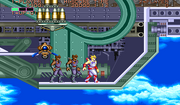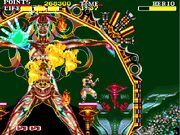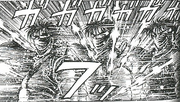Bunshin (分身, lit. Alter Ego or Doppelganger) is an ability Hiryu uses in the first Strider after picking up the "Invincibility" power-up.
Overview
Strider (CPS-1)

A special ability Hiryu performs thanks to his superhuman speed, creating copies of himself in his wake. This ability is activated once Hiryu comes into contact with the "Invincibiliy" item pick-up, which takes the form of a silhouetted Hiryu in a dashing pose.
Once in this state, Hiryu's body is wrapped in light and two afterimages or shadow copies of himself appear behind him[1]. Both "shadows" trail behind him and imitate every action he makes, jumping and attacking shortly after the original does so. For the duration of this move, Hiryu also becomes invincible, being unaffected by any attack from enemies.
Hiryu is said to be able to hold this state for 30 seconds[1], although in-game it actually lasts for exactly 15 seconds (at 60 frames per second for a total of 900 frames).
In Cannon Dancer

A more complex version is featured as one of Kirin's primary skills in Isuke's spiritual sequel Cannon Dancer. Although similar in concept, this version is described as an evolution of the Option A mechanic from Strider.[2]
Bunshin in Cannon Dancer is a power-up system instead of a temporary super mode. By picking up the red capsule items, Kirin gains a power up and is able to summon "shadow clones"[2] of himself to assist in attacking. The shadow clones take the form of a blinking orange-colored copy of Kirin, created on the spot the moment Kirin performs an attack. These copies stand idle in place (or in mid-air if done while jumping) and perform kick attacks in unison with Kirin. As they can be placed anywhere on-screen, they are best used to strike at larger bosses from a safe distance or to intercept the smaller and quicker bosses as they move around. The clones stand in place for roughly 6 seconds, after which they fly back to Kirin's position and "merge" back into him. As they still copy Kirin's attack as they fly back, this can also be used to strike easier or moving targets.
Each power-up level is identified by the color of Kirin's pants: the first level turns his pants red and allows a single clone to be summoned, the second level turns his pants purple and allows two clones to be summoned and the third level turns his pants white and allows four clones to be summoned. Since the clones are created the moment the attack button is pressed, button mashing usually makes all clones stand in a straight line very close to each other, so this skill requires some thinking in order to make the best use of a fully leveled-up Kirin. The power-up can only be lost if Kirin is hit, in which case he drops down a level; or when killed, in which case he respawns with zero power-ups.
The final level of power-up granted by the red capsule is unrelated to this skill, and instead increases the strength and range of Kirin's physical attacks for a short time. Note that shadow clones don't imitate this extended kick range.
Other appearances

- Hiryu displays this ability during the 5th chapter of the manga, where he dodges automatic machinegun fire from 3 soldiers carrying Shadow Tag Bullets, leaving a trail of afterimages as he moves both sideways and forward, approaching and eventually killing his assailants. Hiryu is so fast that he also appears to be practically intangible (mirroring the game's invulnerability), since he's not touched by the bullet storm from three Shadow Tag Bullets (which can automatically track high-speed targets) and moves at such speed the radar used by the weapons can't actually track his movement[3], all the while inside a small room.
- This ability probably inspired two moves from the Marvel vs. Capcom series: the Vajra teleport-kick move and the Ragnarok Hyper Combo. In both instances Hiryu moves at high speed, creating four afterimages as he attacks his opponent.
- Hiryu also splits into three copies in his Dramatic Finish from the cancelled Capcom Fighting All-Stars, although in this move he's seen summoning his copies by placing his hand in front of him with two fingers raised, a typical hand seal used by ninja in popular culture.
Gallery
References
- ↑ 1.0 1.1 Capcom (October 24, 2006, PlayStation). Capcom Gamebook: Strider Hiryu (Japanese). Pg. 12. ISBN 4-86233-076-2.
- ↑ 2.0 2.1 Yotsui, Kouichi; Kogure, Takashi (April 13, 2023). Cannon Dancer Material Book, "Kouichi Yotsui & Utata Kiyoshi Cannon Dancer Dialogue" (English). Included with the Collector's Edition of Cannon Dancer. Pg. 71.
- ↑ Wada, Tatsumi (November 10, 1989). Strider Hiryû. Chapter 5, Pg. 176. Kadokawa Shoten. ISBN 4-04-713009-5.
| Cannon Dancer |
|---|
| Kirin |
| Moves: Bunshin • Cartwheel Jump • Plasma Whirlwind • Slide • Taijutsu |
| Stage Enemies |
| Foot Soldier • Spider Weapon • Flying Weapon • Guardian • Tiger • Desert creatures • Draft • Black Commander Mizuchi • T-Tank • Ijiryu • Flame Fairy |
| Bosses |
| Material • Computer • Gamran • Visete • Herio • Sandora • Euro-Gam • Fake Tianon • Cannons • Willf • Die Rudel Taktik • Slaver |
| Locations |
| Agadan • Slaver Temple • Cabil • Indian Ocean • Woods & Prague • Saskiraf |
| Related Articles |
| The Federation (Jack Layzon) • Slaver (cult) • Teki |


